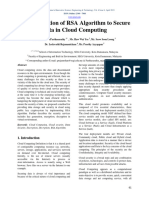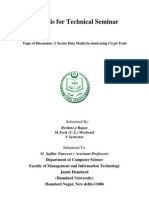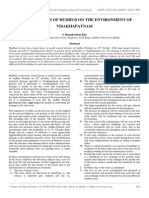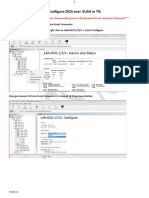Ijret - Enhanced Security Framework To Ensure Data Security in Cloud Using Security Blanket Algorithm
Ijret - Enhanced Security Framework To Ensure Data Security in Cloud Using Security Blanket Algorithm
IJRET: International Journal of Research in Engineering and Technology
eISSN: 2319-1163 | pISSN: 2321-7308
ENHANCED SECURITY FRAMEWORK TO ENSURE DATA SECURITY IN CLOUD USING SECURITY BLANKET ALGORITHM
Sanjeev Kumar Mandal1, Farzeen Basith2
1
Post Graduate student, 2Assistant Professor, Department of MCA, Acharya Institute of Technology, Karnataka, India, sanjeev.mandal93@gmail.com, farzeen107@gmail.com
Abstract
Data security and Access control is a challenging research work in Cloud Computing. Cloud service users upload there private and confidential data over the cloud. As the data is transferred among the server and client, the data is to be protected from unauthorized entries into the server, by authenticating the users and provide high secure priority to the data. So the Experts always recommend using different passwords for different logins. Any normal person cannot possibly follow that advice and memorize all their usernames and passwords. That is where password managers come in. The purpose of this paper is to secure data from unauthorized person using Security blanket algorithm.
----------------------------------------------------------------------***-----------------------------------------------------------------------1. INTRODUCTION
Cloud computing is a paradigm of computing, a new way of thinking about IT industry but not any specific technology. It is a paradigm shift whereby details are abstracted from the users who no longer need knowledge of, expertise in, or control over the technology infrastructure "in the cloud" that supports them. The main concept of cloud computing services is that these services are carried out on behalf of users with hardware that the customers do not own or operate. The user inputs data to the cloud, the data are processed by the cloud service provider according to the instructions of the user, and the output is delivered back to the user. cloud provider. Some examples include services aimed at the general public, such as online photo storage services, e-mail services, or social networking sites. However, services for enterprises can also be offered in a public cloud.In a private cloud, the cloud infrastructure is operated solely for a specific organization, and is managed by the organization or a third party. In a community cloud, the service is shared by several organizations and made available only to those groups. The infrastructure may be owned and operated by the organizations or by a cloud service provider. A hybrid cloud is a combination of different methods of resource pooling (for example, combining public and community clouds).
1.1 Service Models
The cloud computing service models are Software as a Service (SaaS), Platform as a Service (PaaS) and Infrastructure as a Service (IaaS). In Software as a Service model, a pre-made application, along with any required software, operating system, hardware, and network are provided. In PaaS, an operating system, hardware, and network are provided, and the customer installs or develops its own software and applications. The IaaS model provides just the hardware and network; the customer installs or develops its own operating systems, software and applications.
1.3 Security
Security refers to confidentiality, integrity and availability, which pose major issues for cloud vendors. Confidentiality refers to who stores the encryption keys - data from company A, stored in an encrypted format at company B must be kept secure from employees of B; thus, the client company should own the encryption keys. From the perspective of data security, which has always been an important aspect of quality of service, Cloud Computing inevitably poses new challenging security threats for number of reasons. Traditional cryptographic primitives for the purpose of data security protection cannot be directly adopted due to the users loss control of data under Cloud Computing. Therefore,
1.2 Cloud Services
Cloud services are typically made available via a private cloud, community cloud, public cloud or hybrid cloud. Generally speaking, services provided by a public cloud are offered over the Internet and are owned and operated by a
__________________________________________________________________________________________
Volume: 02 Issue: 10 | Oct-2013, Available @ http://www.ijret.org 225
IJRET: International Journal of Research in Engineering and Technology
verification of correct data storage in the cloud must be conducted without explicit knowledge of the whole data. Recently, the importance of ensuring the remote data integrity has been highlighted by the following research works [1][2]. These techniques, while can be useful to ensure the storage correctness without having users possessing data, cannot address all the security threats in cloud data storage, since they are all focusing on single server scenario and most of them do not consider dynamic data operations.
eISSN: 2319-1163 | pISSN: 2321-7308
storage in Cloud Computing. We first identify the difficulties and potential security problems of direct extensions with fully dynamic data updates from prior works and then show how to construct an elegant verification scheme for seamless integration of these two salient features in our protocol design. Achieving Secure, Scalable, and Fine-grained Data Access Control in Cloud Computing This paper proposed some services for data security and access control when users outsource sensitive data for sharing on cloud servers. This paper addresses this challenging open issue by, on one hand, defining and enforcing access policies based on data attributes, and on the other hand allowing the data owner to delegate most of the computation tasks involved in fine grained data access control to untrusted cloud servers without disclosing the underlying data contents. This scheme enables the data owner to delegate tasks of data file reencryption and user secret key update to cloud servers without disclosing data contents or user access privilege information. This goal can be achieved by exploiting and uniquely combining techniques of attribute-based encryption (ABE), proxy re-encryption, and lazy re-encryption [4].
2. LITERATURE REVIEW
While coming with this paper we had visited many small scale industries and companies those are recently using cloud services for outsourcing there confidential data over the cloud and are suffering with some problems while exchanging keys and accessing the services. They are also worried about the recent security techniques, which are currently available. For this paper we have refer the technical paper on Secure Data Access over Cloud Computing and Secure Data Access in Cloud Computing. Data outsourcing in Cloud Computing is fast becoming economically viable for large enterprises. In fact,this data outsourcing is ultimately retrieving users control over its own data and does not provide any assurance on data integrity and availability. On behalf of cloud user, a third party auditor (TPA) who has resources and experience that a user does not have can be emplaced to audit the integrity of large data storage. But user data privacy is still exposed to a TPA, which is required to be secured against unauthorized leakage. Wang and Sherman et al. [3] have proposed a public auditing system of data storage security by developing a privacy preserving auditing protocol. By which auditor can audit without having knowledge of users data contents. Wang and Sherman also proposed a batch auditing protocol where multiple auditing tasks from different users can be performed simultaneously by a TPA. A public auditing scheme consisting four algorithms (KeyGen, SigGen, GenProof, VerifyProof) has been used. KeyGen is run by the user to set up the scheme. SigGen is used to generate verification metadata. GenProof is executed by Cloud Server to provide a proof of data storage correctness. VerifyProof is run by TPA to audit the proof from Cloud Server. Enabling Public Vefiraibility and Data Dynamics for Storage Security in Cloud Computing (2009) describes that Cloud Computing has been envisioned as the next generation architecture of IT Enterprise. It moves the application software and databases to the centralized large data centers, where the management of the data and services may not be fully trustworthy. This unique paradigm brings about many new security challenges, which have not been well understood. This work studies the problem of ensuring the integrity of data
3. PROBLEM STATEMENT
Authentication is the process of determining whether someone or something is, in fact, who or what it is declared to be. In private and public computer networks (including the Internet), authentication is commonly done through the use of logon passwords. Knowledge of the password is assumed to guarantee that the user is authentic. Each user registers initially (or is registered by someone else), using an assigned or self-declared password. On each subsequent use, the user must know and use the previously declared password. The weakness in this system for transactions that are significant (such as the exchange of money) is that passwords can often be stolen, accidentally revealed, or forgotten.
3.1 User:
User, who have data to be stored in the cloud and rely on the cloud for data computation, consists of both individual consumer and organization and want access to cloud server for doing job with effect of Security blanket algorithm
3.2 Cloud service provider (CSP):
Cloud service providers offer cloud solutions, like Google Apps, that are delivered electronically over the internet. Unlike a managed service provider, cloud service providers do not sell or install hardware everything they offer is stored online and accessible securely from anywhere. There are many advantages to working with a cloud service provider like Cloud Sherpas when switching from your old email and collaboration software.
__________________________________________________________________________________________
Volume: 02 Issue: 10 | Oct-2013, Available @ http://www.ijret.org 226
IJRET: International Journal of Research in Engineering and Technology
eISSN: 2319-1163 | pISSN: 2321-7308
3.3 Authentication Service AS:
An authentication service that knows the password of all users and stores these in a centralized database in addition, the AS shares a unique secret key with each server.
All communications between the Security blanket algorithm application and the Security blanket algorithm servers are secured with HTTPS. HTTPS connections on the client side are performed using OpenSSL. The HTTPS communications between Security blanket algorithm application and Security blanket algorithms servers are using SSLv3, TLS_RSA_WITH_AES_256_CBC_SHA connections. SSL protocol main steps are as follows: The client and the server negotiate to choose the best cipher and hash algorithm available on both sides. The server sends his digital certificate. The client verifies the certificate by contacting a Certificate Authority. The client encrypts a random number with the servers public key, and sends it to the server. The server decrypts this number, and both sides use this number to generate a symmetric key, used to encrypt and decrypt data.
Figure 1: Authentication using Security blanket algorithm
4. PROPOSED METHOD
Security blanket algorithm is a new password manager that can best be described as a mix of Roboform and LastPass. With Security blanket algorithm users have the ability to securely store their logins. These logins can then be kept locally on your computer only or synced with your Security blanket algorithm account and accessible on any computer or device that you install Security blanket algorithm on. Currently Windows, Mac OS X, Android, and iOS are supported by Security blanket algorithm so with the sync feature you could potentially have your logins on every computer or device you use.
Finally, communication between the Security blanket algorithm Browser Plug-in and the Security blanket algorithm Application is secured using with AES 256 with the OpenSSL library: A 32 bytes salt is generated using the OpenSSL RAND_bytes function (ciphering) or reading it from the inter process message (deciphering) The Security blanket algorithm Private Key is used, with the salt, to generate the AES 256 bit key that will be used for (de)ciphering. This generation is performed using the OpenSSL EVP_BytesToKey, using SHA1, with 5 iterations. The 32 bytes initialization vector is generated with the OpenSSL EVP_BytesToKey function, using SHA1 . Then, the data is (de)ciphered using CBC mode. When ciphering, the salt is written on inter process message.
5. IMPLEMENTATION
Figure 2: Security blanket algorithm Server-AWS Allows users to store unlimited logins (usernames and passwords). Logins can be sorted into specific categories, e.g. email or social media. Has excellent browser integration supports Firefox, Chrome, and Internet Explorer. In addition to logins, users can store credit card numbers, bank accounts, contacts, social security numbers, tax ids, and more. UPDATE: It looks like notes are only available in Premium (paid version) now.
__________________________________________________________________________________________
Volume: 02 Issue: 10 | Oct-2013, Available @ http://www.ijret.org 227
IJRET: International Journal of Research in Engineering and Technology
eISSN: 2319-1163 | pISSN: 2321-7308
Has an optional built-in receipt tracker to help you keep track of your purchases, online or offline. Has a built-in tool that tells you how strong your passwords are. Can generate random passwords. Secures data with AES 256 encryption.
Has the ability to sync data across Security blanket algorithm on all computers and devices Windows, Mac OS X, Android, and iOS Sync is optional users can opt to keep data stored locally only. Has the ability to import data from LastPass, Roboform, KeePass, Password Wallet, 1Password, Chrome, Firefox, and Internet Explorer. Has a web version for access to your logins when at a computer which doesnt have Security blanket algorithm installed.
6. RESULT AND EVOLUTION
The initial registration for a user follows the flow described Figure 4: Two-Factor authentication When adding a second device, the important point is that Security blanket algorithm needs to make sure the user adding the additional device is indeed the legitimate owner of the account. This is to gain additional protection in the event the user Master Password has been compromised and an attacker who does not have access to his already enabled device is trying to access the account from another device. As shown on Figure 4, when a user is attempting to connect to a Security blanket algorithm account on a device that has not yet been authorized for this account, Security blanket algorithm generates a One-Time Password (a Token) that is being sent to the user either to the email address used to create the Security blanket algorithm account initially, or by text message to the users mobile phone if the user has chosen to provide his mobile phone number. In order to enable the new device, the user has to enter both his User Master Password and the Token. Only after this TwoFactor authentication has been performed will Security blanket algorithm servers start synchronizing the user data on the new device. All communication is handled with HTTPS and the user data only travels in AES-256 encrypted form. Please note again that the user Master Password never transits on the Internet.
Figure 3: Authentication flow during registration. As can be seen in Figure 3, the User Master Password is never user to perform Server Authentication, and the only keys stored on our servers are the User Device keys.
__________________________________________________________________________________________
Volume: 02 Issue: 10 | Oct-2013, Available @ http://www.ijret.org 228
IJRET: International Journal of Research in Engineering and Technology
eISSN: 2319-1163 | pISSN: 2321-7308
REFERENCES
[1]. A. Juels and J. Burton S. Kaliski, PORs: Proofs of Retrievability for Large Files, Proc. of CCS 07, pp. 584 597, 2007 [2]. G. Ateniese, R. D. Pietro, L. V. Mancini, and G. Tsudik, Scalable and Efficient Provable Data Possession, Proc. of SecureComm 08, pp. 110, 2008. [3]. Wang, Sherman, Kui, Lou, Privacy-Preserving Public Auditing for Secure Cloud Storage", INFOCOM, 2010 Proceedings IEEE, 14-19March, 2010. [4]. S. Yu, C. Wang, K. Ren, and W. Lou, Achieving secure, scalable, and fine-grained data access control in cloud computing, in IEEE INFOCOM'10, 2010. [5] L. Chen, Gongde Guo An Efficient Remote Data Possession Checking in Cloud Storage, Fujian Normal University, vol. 5, no. 4, April 2011. [6] Sheng Zhong and Zhuo Hao. A Privacy-Preserving Remote Data Integrity Checking Protocol with Data Dynamics and Public Verifiability, IEEE Internet Computing, 2010. [7] Cong Wang, Kui Ren, Qian Wang and Wenjing Lou "Towards Secure and Dependable Storage Services in Cloud Computing," IEEE transactions on Services Computing, vol 5, no. 3, pp 220-232, 2011.
Even though what goes on in the background during the initial registration steps is complex (See Figure 3) and highly secure, the perception by the user could not be simpler. All he has to do is to pick a (strong) User Master Password. All the other keys are generated by the application without user intervention.
BIOGRAPHIES
Post Graduate student Department of MCA, Acharya Institute of Technology, Karnataka, India,
Assistant Professor, Department of MCA, Acharya Institute of Technology, Karnataka, India. Teaching Experience: 9 year
When adding an additional device, the process is equally simple, while remaining highly secure through the use of Two-Factor authentication described in Figure 4.
CONCLUSIONS
Sensitive data storage on cloud platform is challenging while adopting cloud services for data storage. Cryptographic keys are sensitive data and required on cloud platform in different cases but cannot store directly on cloud. This paper discuses Security blanket algorithm key management on cloud based environment. Security blanket algorithm is a new service that does that, audits those passwords for strength, saves your form information for quick entry on new web sites, and even keeps track of the purchases you make with that information so you can see it all in one viewone that's only available to you, not even Security blanket algorithm employees.
__________________________________________________________________________________________
Volume: 02 Issue: 10 | Oct-2013, Available @ http://www.ijret.org 229
You might also like
- AZURE AZ 500 STUDY GUIDE-1: Microsoft Certified Associate Azure Security Engineer: Exam-AZ 500From EverandAZURE AZ 500 STUDY GUIDE-1: Microsoft Certified Associate Azure Security Engineer: Exam-AZ 500No ratings yet
- Security Issues in Cloud Computing: Journal of Analysis and Computation (JAC)No ratings yetSecurity Issues in Cloud Computing: Journal of Analysis and Computation (JAC)5 pages
- Cloud Computing Security Issues & Challenges: A Review: Avijit Mondal & Subrata Paul Radha Tamal Goswami Sayan NathNo ratings yetCloud Computing Security Issues & Challenges: A Review: Avijit Mondal & Subrata Paul Radha Tamal Goswami Sayan Nath5 pages
- Cloud: Get All The Support And Guidance You Need To Be A Success At Using The CLOUDFrom EverandCloud: Get All The Support And Guidance You Need To Be A Success At Using The CLOUDNo ratings yet
- Application of Co-Operative Encryption To Clouds For Data Security-2018-01-10-7No ratings yetApplication of Co-Operative Encryption To Clouds For Data Security-2018-01-10-74 pages
- Cloud Computing: The Untold Origins of Cloud Computing (Manipulation, Configuring and Accessing the Applications Online)From EverandCloud Computing: The Untold Origins of Cloud Computing (Manipulation, Configuring and Accessing the Applications Online)No ratings yet
- Cloud Computing: A Comprehensive Guide to Cloud Computing (Your Roadmap to Cloud Computing, Big Data and Linked Data)From EverandCloud Computing: A Comprehensive Guide to Cloud Computing (Your Roadmap to Cloud Computing, Big Data and Linked Data)No ratings yet
- Secure Cloud Computing Using Aes and Rsa Algorithms: K.R.MonishaNo ratings yetSecure Cloud Computing Using Aes and Rsa Algorithms: K.R.Monisha6 pages
- Accessing Secured Data in Cloud Computing EnvironmentNo ratings yetAccessing Secured Data in Cloud Computing Environment10 pages
- A Survey On Security and Privacy in Cloud Computing: Mir Toornaw IslamNo ratings yetA Survey On Security and Privacy in Cloud Computing: Mir Toornaw Islam9 pages
- Cloud Computing Made Simple: Navigating the Cloud: A Practical Guide to Cloud ComputingFrom EverandCloud Computing Made Simple: Navigating the Cloud: A Practical Guide to Cloud ComputingNo ratings yet
- Cloud computing: Moving IT out of the officeFrom EverandCloud computing: Moving IT out of the officeBCS, The Chartered Institute for ITNo ratings yet
- Cloud Security Using Blowfish and Key Management Encryption AlgorithmNo ratings yetCloud Security Using Blowfish and Key Management Encryption Algorithm4 pages
- PP 216-221 A Conceptual Architecture For Securing Public Cloud Moving FromNo ratings yetPP 216-221 A Conceptual Architecture For Securing Public Cloud Moving From6 pages
- A Multikeyword Ranked Search Technique With Provision For Dynamic Update of Encrypted Documents in CloudNo ratings yetA Multikeyword Ranked Search Technique With Provision For Dynamic Update of Encrypted Documents in Cloud8 pages
- Applying_Encryption_Algorithm_for_Data_SNo ratings yetApplying_Encryption_Algorithm_for_Data_S4 pages
- Computer Science Self Management: Fundamentals and ApplicationsFrom EverandComputer Science Self Management: Fundamentals and ApplicationsNo ratings yet
- Cloud Computing-1 (1) With Pages RemovedNo ratings yetCloud Computing-1 (1) With Pages Removed6 pages
- AZURE AZ 500 STUDY GUIDE-2: Microsoft Certified Associate Azure Security Engineer: Exam-AZ 500From EverandAZURE AZ 500 STUDY GUIDE-2: Microsoft Certified Associate Azure Security Engineer: Exam-AZ 500No ratings yet
- Security Model For Secure Storage in Cloud EnvironmentNo ratings yetSecurity Model For Secure Storage in Cloud Environment8 pages
- Data Storage Security Challenges in Cloud Computing100% (1)Data Storage Security Challenges in Cloud Computing10 pages
- Data Security Issues in Cloud Environment and Solutions: 2014 World Congress On Computing and Communication TechnologiesNo ratings yetData Security Issues in Cloud Environment and Solutions: 2014 World Congress On Computing and Communication Technologies5 pages
- Cloud Computing Security Issues Problem and Strategy: AbstractNo ratings yetCloud Computing Security Issues Problem and Strategy: Abstract4 pages
- Analysis of Secured Cloud Data Storage ModelNo ratings yetAnalysis of Secured Cloud Data Storage Model24 pages
- The Ultimate Guide to Unlocking the Full Potential of Cloud Services: Tips, Recommendations, and Strategies for SuccessFrom EverandThe Ultimate Guide to Unlocking the Full Potential of Cloud Services: Tips, Recommendations, and Strategies for SuccessNo ratings yet
- Data Security On Cloud Computing: Azhar UshmaniNo ratings yetData Security On Cloud Computing: Azhar Ushmani4 pages
- A Survey On Data Security in Cloud Computing Issues and Mitigation TechniquesNo ratings yetA Survey On Data Security in Cloud Computing Issues and Mitigation Techniques5 pages
- Data Security in Cloud Oriented Application Using SSL/TLS ProtocolNo ratings yetData Security in Cloud Oriented Application Using SSL/TLS Protocol7 pages
- INSPIRA-JOURNAL-OF-COMMERCEECONOMICS-COMPUTER-SCIENCEJCECS-Vol-05-No-03-July-September-2019-Pages-232-to-236No ratings yetINSPIRA-JOURNAL-OF-COMMERCEECONOMICS-COMPUTER-SCIENCEJCECS-Vol-05-No-03-July-September-2019-Pages-232-to-2365 pages
- Security and Privacy Approach of Cloud Computing EnvironmentNo ratings yetSecurity and Privacy Approach of Cloud Computing Environment4 pages
- Survey On Data Security Issues and Data Security Models in Cloud ComputingNo ratings yetSurvey On Data Security Issues and Data Security Models in Cloud Computing5 pages
- Addressing Security and Privacy Issues in Cloud Co 5979b75b1723dd91e8e5217fNo ratings yetAddressing Security and Privacy Issues in Cloud Co 5979b75b1723dd91e8e5217f12 pages
- Groundwater Investigation Using Geophysical Methods - A Case Study of Pydibhimavaram Industrial AreaNo ratings yetGroundwater Investigation Using Geophysical Methods - A Case Study of Pydibhimavaram Industrial Area5 pages
- Likely Impacts of Hudhud On The Environment of VisakhapatnamNo ratings yetLikely Impacts of Hudhud On The Environment of Visakhapatnam3 pages
- Secure Data Dissemination Protocol in Wireless Sensor Networks Using Xor Network CodingNo ratings yetSecure Data Dissemination Protocol in Wireless Sensor Networks Using Xor Network Coding5 pages
- Best Lookup Algorithm For 100+GBPS Ipv6 PacketNo ratings yetBest Lookup Algorithm For 100+GBPS Ipv6 Packet8 pages
- UD26609B iVMS-4200-AC-Client User-Manual V1.7.0 PDF1-TEST en-US 20211221No ratings yetUD26609B iVMS-4200-AC-Client User-Manual V1.7.0 PDF1-TEST en-US 20211221154 pages
- 4G Huawei CELLCOUNTERPARAGROUP StandarizationNo ratings yet4G Huawei CELLCOUNTERPARAGROUP Standarization3 pages
- Fast Phrase Search For Encrypted Cloud StorageNo ratings yetFast Phrase Search For Encrypted Cloud Storage50 pages
- 2018 Sundray 2 Wireless Data Forwording - v3.6.7No ratings yet2018 Sundray 2 Wireless Data Forwording - v3.6.739 pages
- SIMOS.3003.IKEv2.FlexVPN.SVTI.with.PSK.v001No ratings yetSIMOS.3003.IKEv2.FlexVPN.SVTI.with.PSK.v00111 pages
- Shakira Muhammed Kunhi: Mobile: +965-69692267, Kuwait EmailNo ratings yetShakira Muhammed Kunhi: Mobile: +965-69692267, Kuwait Email3 pages
- MCF DAS Specifications 2009 Final300709No ratings yetMCF DAS Specifications 2009 Final30070943 pages
- AZURE AZ 500 STUDY GUIDE-1: Microsoft Certified Associate Azure Security Engineer: Exam-AZ 500From EverandAZURE AZ 500 STUDY GUIDE-1: Microsoft Certified Associate Azure Security Engineer: Exam-AZ 500
- Security Issues in Cloud Computing: Journal of Analysis and Computation (JAC)Security Issues in Cloud Computing: Journal of Analysis and Computation (JAC)
- Cloud Computing Security Issues & Challenges: A Review: Avijit Mondal & Subrata Paul Radha Tamal Goswami Sayan NathCloud Computing Security Issues & Challenges: A Review: Avijit Mondal & Subrata Paul Radha Tamal Goswami Sayan Nath
- Network Coding and Signcryption for Cloud Data IntegrityFrom EverandNetwork Coding and Signcryption for Cloud Data Integrity
- Cloud: Get All The Support And Guidance You Need To Be A Success At Using The CLOUDFrom EverandCloud: Get All The Support And Guidance You Need To Be A Success At Using The CLOUD
- Application of Co-Operative Encryption To Clouds For Data Security-2018-01-10-7Application of Co-Operative Encryption To Clouds For Data Security-2018-01-10-7
- Cloud Computing: The Untold Origins of Cloud Computing (Manipulation, Configuring and Accessing the Applications Online)From EverandCloud Computing: The Untold Origins of Cloud Computing (Manipulation, Configuring and Accessing the Applications Online)
- Cloud Computing: A Comprehensive Guide to Cloud Computing (Your Roadmap to Cloud Computing, Big Data and Linked Data)From EverandCloud Computing: A Comprehensive Guide to Cloud Computing (Your Roadmap to Cloud Computing, Big Data and Linked Data)
- Secure Cloud Computing Using Aes and Rsa Algorithms: K.R.MonishaSecure Cloud Computing Using Aes and Rsa Algorithms: K.R.Monisha
- Accessing Secured Data in Cloud Computing EnvironmentAccessing Secured Data in Cloud Computing Environment
- A Survey On Security and Privacy in Cloud Computing: Mir Toornaw IslamA Survey On Security and Privacy in Cloud Computing: Mir Toornaw Islam
- Cloud Computing Made Simple: Navigating the Cloud: A Practical Guide to Cloud ComputingFrom EverandCloud Computing Made Simple: Navigating the Cloud: A Practical Guide to Cloud Computing
- Cloud computing: Moving IT out of the officeFrom EverandCloud computing: Moving IT out of the office
- Cloud Security Using Blowfish and Key Management Encryption AlgorithmCloud Security Using Blowfish and Key Management Encryption Algorithm
- PP 216-221 A Conceptual Architecture For Securing Public Cloud Moving FromPP 216-221 A Conceptual Architecture For Securing Public Cloud Moving From
- A Multikeyword Ranked Search Technique With Provision For Dynamic Update of Encrypted Documents in CloudA Multikeyword Ranked Search Technique With Provision For Dynamic Update of Encrypted Documents in Cloud
- Computer Science Self Management: Fundamentals and ApplicationsFrom EverandComputer Science Self Management: Fundamentals and Applications
- AZURE AZ 500 STUDY GUIDE-2: Microsoft Certified Associate Azure Security Engineer: Exam-AZ 500From EverandAZURE AZ 500 STUDY GUIDE-2: Microsoft Certified Associate Azure Security Engineer: Exam-AZ 500
- Security Model For Secure Storage in Cloud EnvironmentSecurity Model For Secure Storage in Cloud Environment
- Data Storage Security Challenges in Cloud ComputingData Storage Security Challenges in Cloud Computing
- Data Security Issues in Cloud Environment and Solutions: 2014 World Congress On Computing and Communication TechnologiesData Security Issues in Cloud Environment and Solutions: 2014 World Congress On Computing and Communication Technologies
- Cloud Computing Security Issues Problem and Strategy: AbstractCloud Computing Security Issues Problem and Strategy: Abstract
- The Ultimate Guide to Unlocking the Full Potential of Cloud Services: Tips, Recommendations, and Strategies for SuccessFrom EverandThe Ultimate Guide to Unlocking the Full Potential of Cloud Services: Tips, Recommendations, and Strategies for Success
- A Survey On Data Security in Cloud Computing Issues and Mitigation TechniquesA Survey On Data Security in Cloud Computing Issues and Mitigation Techniques
- Data Security in Cloud Oriented Application Using SSL/TLS ProtocolData Security in Cloud Oriented Application Using SSL/TLS Protocol
- CCSP - Certified Cloud Security Professional Exam InsightsFrom EverandCCSP - Certified Cloud Security Professional Exam Insights
- INSPIRA-JOURNAL-OF-COMMERCEECONOMICS-COMPUTER-SCIENCEJCECS-Vol-05-No-03-July-September-2019-Pages-232-to-236INSPIRA-JOURNAL-OF-COMMERCEECONOMICS-COMPUTER-SCIENCEJCECS-Vol-05-No-03-July-September-2019-Pages-232-to-236
- Security and Privacy Approach of Cloud Computing EnvironmentSecurity and Privacy Approach of Cloud Computing Environment
- Survey On Data Security Issues and Data Security Models in Cloud ComputingSurvey On Data Security Issues and Data Security Models in Cloud Computing
- Addressing Security and Privacy Issues in Cloud Co 5979b75b1723dd91e8e5217fAddressing Security and Privacy Issues in Cloud Co 5979b75b1723dd91e8e5217f
- Groundwater Investigation Using Geophysical Methods - A Case Study of Pydibhimavaram Industrial AreaGroundwater Investigation Using Geophysical Methods - A Case Study of Pydibhimavaram Industrial Area
- Likely Impacts of Hudhud On The Environment of VisakhapatnamLikely Impacts of Hudhud On The Environment of Visakhapatnam
- Secure Data Dissemination Protocol in Wireless Sensor Networks Using Xor Network CodingSecure Data Dissemination Protocol in Wireless Sensor Networks Using Xor Network Coding
- UD26609B iVMS-4200-AC-Client User-Manual V1.7.0 PDF1-TEST en-US 20211221UD26609B iVMS-4200-AC-Client User-Manual V1.7.0 PDF1-TEST en-US 20211221
- Shakira Muhammed Kunhi: Mobile: +965-69692267, Kuwait EmailShakira Muhammed Kunhi: Mobile: +965-69692267, Kuwait Email





























































































